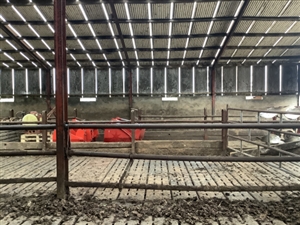The shed comprises steel columns and trusses with corrugated iron sheeting over. The floor comprises re-Inforced concrete slats over the slurry tank. The pens have steel barriers supported by steel posts all of which are heavily corroded but still making contact with other albeit fortuitously.
The earthing system is TT with the shed steelwork on its own providing a substantially low impedance of 5 ohms using a loop tester. A 100mA RCD protects the rather ropey lighting circuits.

whilst the floor could be wet, I can’t conceive how a voltage difference could be established even if the steelwork was at 230v
